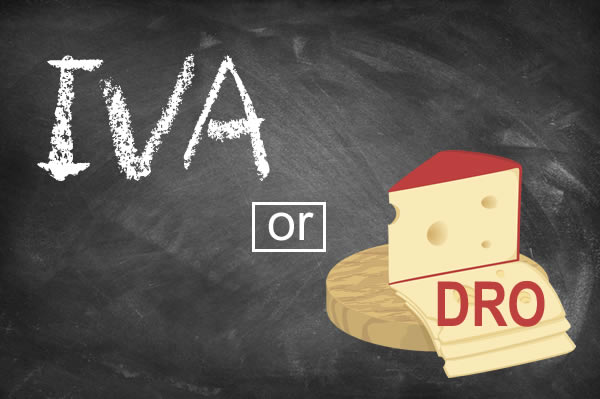Everyone has heard of bankruptcy, but Debt Relief Orders (DROs) and Individual Voluntary Arrangements (IVAs) are less well known.
Here is a comparison of IVAs and DROs, so you can see would be better for you.
DROs and IVAs were the two most common types of personal insolvency in England and Wales in 2023.
Some choices between debt solutions are genuinely hard. When I wrote about comparing IVAs with DMPs, I said they were like apples and pears…there are pros and cons for both.
But for DROs and IVAs, it’s more like chalk and cheese – and luckily the choice turns out to be easy!

Comparing DROs and IVAs
One of the problems about saying anything useful about IVAs is that, in theory, they can vary massively. If I put “it depends” on most lines in the IVA column in the table below, that wouldn’t be at all helpful.
But most IVAs follow a set pattern and that is what I am describing here. I have also tried to give an indication of how often something can be a problem.
| DROs | IVAs | |
|---|---|---|
| max debt | this is being increased to £50,000 in June 2024 | no maximum |
| own house? | no | yes – may have to release equity in last year |
| own car | the permitted value of a car is being increased to £4,000 in June 2024 | usually not a problem |
| car on finance | often a problem | sometimes a problem eg when finance ends during IVA |
| other assets | no more than £2,000 (second-hand value – normal household possessions are ignored) | usually not a problem |
| spare income | less than £75 a month according to DRO calculations | more than £50 a month according to IVA calculations |
| can creditors still chase | no | no |
| interest frozen | yes | yes |
| fee | no fee at all | £3500+ paid from monthly payments |
| monthly payments | none | yes – may change at annual review |
| duration | 1 year | usually 5 or 6 years – may be extended. 8% last more than 7 years |
| failure rate | very low – 1% | very high – Covid payment breaks make recent numbers hard to assess, but it may be over 20% for IVAs started in the last few years |
| how public | on insolvency register for 1 year | on insolvency register until completes |
| credit record | on for 6 years | on for 6 years or longer until it completes |
| borrow money | very difficult – must inform lender about DRO if borrow more than £500 | very difficult – need permission from IVA firm to borrow more than £500 |
| employment | rarely affected | rarely affected |
| can be company director | no – being a sole trader is OK | yes |
Can you have a DRO?
You need to find out if you can have a DRO, not guess from the above table. What is a DRO? looks at the rules in detail.
The hardest rule for you to assess is the “less than £75 a month spare income” test.
If an IVA firm says your IVA monthly payment would be £100, you may still be able to pass the “under £75 a month spare income” DRO test because the calculations are not the same.
As a rule of thumb, if:
- you are renting AND
- your debts are less than the DRO maximum limit of £50,000 AND
- an IVA firm says you would pay less than £125 a month
you need to talk to a free sector debt adviser about whether you qualify for a DRO. IVA firms are not DRO experts and some are, frankly, trying to sell you an IVA because of the fees they get.
(And if you are renting and you can’t have a DRO you should consider bankruptcy, but that is a whole different article!)
If you can have a DRO it will be better than an IVA – simple!
The two key lines in the table are monthly payments and failure rate.
In a DRO you don’t pay any monthly payments. In an IVA you make payments for at least five years. Say an IVA firm says your payments would be £125 a month – that would be £7,500 over five years.
So obviously you will be much better off in a DRO.
Also a DRO is massively less likely to go wrong and fail. And it finishes after a year, whereas an IVA means stress and monthly payments and annual reviews for 5 years.
The main reason IVAs fail is when someone can no longer afford to make the payments. Five or six years is a long time, things change in your life and the economy – new baby, redundancy, Covid, cost of living crisis, etc. If you start with low IVA payments, say £150 a month, there is very little room to reduce your payments if your income falls or your expenses go up. Your IVA may well fail.
In summary, a DRO finishes quicker, you don’t have to make any payments and it very rarely fails.



V says
Where can I go to arrange a DRO?
Sara (Debt Camel) says
You can go to your local Citizens Advice or you can phone National Debtline on 0808 808 4000.
If a DRO is not a good option for you, the debt adviser can look at what your other choices are.
Daniel Griffiths says
Another great unbiased article
Hilary says
As usual your articles are very informative and helpful x
S says
Hi
I entered into an IVA in January this year with Payplan.
I have debts around £23k ( one being HMRC).
I advised Payplan at the time that I would be changing job in March with the same salary.
My council tax has gone up by £23 a month ( £23 above the figure in my plan) and under new legislation I have to pay 5% of my salary to a pension.
I now have a negative balance of minus £53 a month on my income / expenditure
Payplan are now saying my IVA is not suitable but have offered no alternative solution or comments..
What can I do ?
Jan Williams says
Great article. I am going to save it as a reference source. Thank you
Issy says
I’m currently on an Iva finishing in 3 years, recently I’ve had refunds in 5 loans and the debts are clear , can I ask for these to now be removed from the Iva subsequently lower my debt ?
Sara (Debt Camel) says
How large were the refunds?
Kelly says
Hi
I took a loan out before covid as I was going to buy a van and have a holiday. Then all this shit happened, I lost my job and my ex stopped contributing to his kids. Will a DRO help me with the loan and credit card bills? Any advice appreciated x
Weatherman says
Hi Kelly
It entirely depends on your circumstances. The basic criteria for a DRO are:
– Under £50 disposable income a month
– Assets (savings/investments/property) of under £1,000
– Either no vehicle or a vehicle worth under £1,000
– Relevant debts of under £20,000 (some debts can’t be included in a DRO, like court fines, or debts that are secured against property)
If you meet all those criteria you might be able to get a DRO. But really before you decide exactly route you want to go down, you should speak to a debt adviser, who can look at your whole situation and go through your different options and their implications. Call National Debtline on 0808 808 4000
Sara (Debt Camel) says
I agree you need debt advice. Loans and credit card debts can go into a DRO – as can utility bills, payday loans, catalogues etc
But you need an expert like the National Debtline advisers to look at your whole situation and explain your options and the pros and cons of each.
Andy Osborne says
Hi, I took out an IVA as advised in June 2019 with debts just over £14k. Thing is, I was never advised by the company about the option of a DRO so signed up and payed £75pcm for the first year which was due to become £50pcm for the following four years.
Started work at Citizens Advice in October 2019 aware that this would affect my payment, on chatting to colleagues and showing them my plan, they were astonished to see that the DRO was never discussed, particularly since at the time, my monthly PIP award of £255 was used for income but nothing included for adult care costs in expenditure, leaving me with a monthly surplus of £55.
When I have previously questioned this with the provider, they explained that the PIP was included as income so as to give me a surplus thus making me eligible for an IVA…. At last years review I made a lump sum payment to cover the increase in income due to my employment and my monthly payment was increased to £173pcm. When I questioned the use of PIP as income without any care costs in the expenditure, I received notice that I had overpaid, I had 2 free months and then payments were reduced back to £50pcm.
I’ve continued with these payments and now my annual review is due. My colleagues at CAB are suggesting I complain about the way in which I was sold the IVA and insist that they would have referred me straight to the DRO unit as the obvious option.
Any thoughts…???
Sara (Debt Camel) says
It is a shame your colleagues didn’t suggest you let the IVA fail in October 2019, then you could have had a DRO back then. Or that you did not query the IVA then.
Who is the IVA firm? You can certainly complain about the IVA being mis-sold as it was not explained to you that a DRO was an option. But what redress should you be asking for? You could ask for the IVA to be closed on the basis of the funds paid to date… that would be unusual so early in an IVA but you can argue it is justified because of the IVA mis-selling. I haven’t seen a case like this won but these complaints are only just starting so it is possible it could be.
Have you had debt advice saying that you would now qualify for a DRO? If you do, then you can simply let the IVA fail now and have a DRO. That would save all the future IVA payments. Also if you have acquired any more debts (utility bill arrears say?) they could go into the DRO. The only downside is (assuming you do qualify for a DRO obviously) is that the DRO marker would be on your credit record for another 6 years, whereas the IVA marker only has another 4 years to go.
Andy says
Thanks for the reply… so, I was volunteering at CAB when I took out the IVA with PayPlan. 4 months later a P/T job came up doing exactly what I was already doing so went for it. Still doing the same job now and income would be way over limit for DRO now.
Thing is, would I have taken a P/T job if I’d been in a DRO rather than an IVA. Well no, is the answer, I’d have ridden that out for a year then maybe taken up work again at a later date. So as my colleagues say to me I’m now paying for something I really wouldn’t have been had I been given the correct advice…???
Andy says
Even my initial advice letter has absolutely no mention of a DRO
Sam says
Hi,
I have been in an IVA for a year and I have £16,000 in debt. I am currently paying £350 p/m. From reading your article, I feel that a DRO is a better option. I fit the criteria (renting/ no car etc) however is it a simple process to leave an IVA and start a DRO? When the DRO is finished in a year’s time, would I be able to apply for mortgages?
Sara (Debt Camel) says
In a DRO you have to have less than £75 a month spare after paying all your essential bills.
If you are managing to pay £350 a month to your IVA, that sound unlikely…
Is the £350 a month a struggle? Do you have expenses your IVA firm is not taking into account?
Paul says
Hi Im about 14k in debt and 16k with my overdraft. Do they include this as paying that off alone is a chore.
Disposable income of under £70 I would say that’s about right but how do they prove this? I pay my ex partner for the upkeep of the kids but it’s not anything set in stone by Csa.
I do have a mortgage with my ex partner still but I pay for the entire upkeep of it
Can you get a dro with a mortgage?
Sara (Debt Camel) says
You cannot get a DRO when you own a property.
What sort of debts do you have at the moment?
The overdraft, are you in this for the whole month, even when you are paid?
Do you have a mortgage fix at the moment – if so when does this end?
Sara L H says
Hi I’m on pip of 283 a month and have an IVA. I wasn’t offered a DRO. Should the pip have been included in my monthly income?
Sara (Debt Camel) says
Sorry quite a few questions:
How far into the IVA are you?
What was the total amount of debt going into the IVA?
Are you buying or renting?
Do you own a car worth over £2000?
What are your monthly IVA payments and are they affordable?
Lou says
Hi, my husband is currently going through the process of getting an IVA but we have been told that we only have £40 spare income for the payment. The debt is £25,000.
I rent the property and my husband isn’t on the tenancy as he moved in afterwards.
We have a Van on lease hire and a car on finance, both of which are business vehicles. They are worth more than £1000 each.
Would my husband still be eligible?
Sara (Debt Camel) says
This IVA is just for your husband? Or is it for your debts as well? Are you both self employed?
the 25k – what sort of debts is this?
Lou says
It’s just for my husband. It’s fro his tax bill bank loan and credit card.
Yes we are both self employed
Sara (Debt Camel) says
So if this is just for his debts, your tenancy and any car finance in your name is not relevant.
I think he should talk to Business Debtline https://www.businessdebtline.org/ on 0800 197 6026 about his situation and whether he would be eligible for a DRO. Cars on finance are complicated, especially for the self employed. This doesn’t mean I am saying he won’t be eligible, just that Business Debtline are the experts in this area.
Lilian says
Has been 6 months that I am paying £100 monthly to IVA(creditfix) which I thought was a good deal at first because I was in debt with more than £6000 and I don’t have any assets just my and small bills but I still got 4 years and half to pay. I didn’t know about DRO and they didn’t mention it either.
Sara (Debt Camel) says
Are these £100 payments easy to mange? Or is it getting harder with rising prices?
Lilian says
Well Sara, I try to administer my money but is not very good to be on the budget most of the time, but it is essential to keep on track obviously would be great to direct this money to something else.
Sara (Debt Camel) says
If you think you will find it difficult to continue to make these payments for the rest of the IVA, then talk to National Debtline on 0808 808 4000 now about whether you would qualify for a DRO.